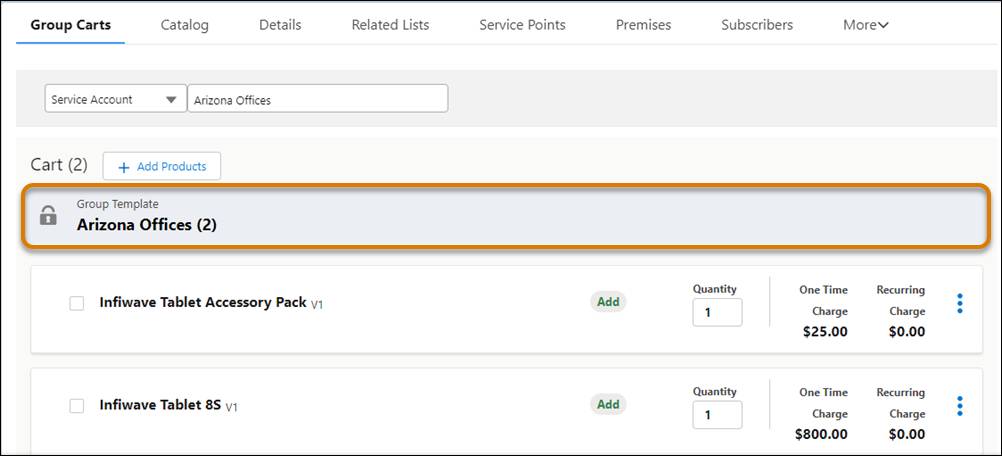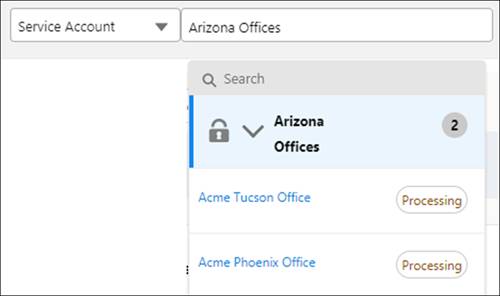Create and Submit Multisite Orders
Learning Objectives
After completing this unit, you’ll be able to:
- Create and configure multisite orders.
- Submit and review multisite orders.
- Check status of multisite orders.
Quotes to Orders
Sophia has spent a few weeks working on quoting a solution for Sai Grover at Acme to upgrade their branch offices with new equipment and services. With her newfound Industries CPQ skills, Sophia created quotes for the offices by using two groups.
- A California Offices group, for Acme’s Alameda and Berkeley offices
- An Arizona Offices group, for Acme’s Phoenix and Tucson offices
Sai is liking the look of this quote, so he emails Sophia to accept the offer. She updates the quote record status to Accepted. Now it’s time to create an order. How can Sophia do this using Industries CPQ multisite capabilities? She has two options, depending on how much of the multisite quote the customer wants to place as an order right now.
Instructions: Click to reveal the scope and find out how to create the order.
Once Sai creates the order, he receives a confirmation message from Industries CPQ and returns to the order.
If your customer only wants to place part of the multisite order, return to the quote later to create additional orders for the other groups and members as needed.
Order Configuration
Here’s an example from the training playground of Acme orders that originated from quotes.

You can create three types of order from multisite quotes.
- A parent order holds details of all the groups and the products associated with those groups. The parent order in the example above is called Acme Az and Ca Sales Teams.
- A group order with details of the members and products associated with each quote group. In the example, the group order name is California Offices.
- A member order that has the order for each individual quote group member. In the example, the two member orders are Quote_Acme Berkeley Office, which stores details of the order for the Berkeley Office, and Quote_Acme Alameda Office, which stores details of the order for the Alameda Office.
Before you submit an order for a specific member, add order-specific information such as the shipping address, or extra information like technical specifications.
Submission and Review of Orders
Click Create and Submit Orders on the group from the parent quote in the group cart to submit orders by group. Alternatively, you can submit orders by each individual member order.
To submit individual member orders, open the member order, and click Submit Order. Access member orders from the group menu in the parent or group order or from the order list.
Any submitted orders are locked for editing, as shown in this parent order example.

Notice the lock symbol beside the Arizona Offices group name. This means the order for this group has been submitted and can’t be amended here.
What happens behind the scenes once you submit a multisite order? Industries CPQ passes each of the associated group member orders to your organization’s order management system for processing and fulfillment. The system treats each submitted member order as an individual order for processing.
Order Status
Check the status of your orders from the parent order group menu, as shown here, or from the Industries CPQ Order list.

The order for the Arizona Offices group in this example has been submitted, so it’s shown as locked in the group menu. The order status for each member order is shown as Processing, meaning that the order is currently being handled for fulfillment. Once the order is complete, the status changes to Activated.
By default, the status of parent and group orders remains as Draft, and the order status stays Ready to Submit. This way you can amend the order name and description of the parent and group orders, if needed. The status of these orders changes as they move through the order management process.
Custom Multisite Order Lists
If you’re working with lots of different orders, you’ll find it easier to monitor progress from the Order list. Because of this, it’s helpful to add the order record type field to your order list view, so you can quickly identify which orders are single-site and which are associated with multisite orders. If you prefer to work from the parent order when reviewing multisite orders, you should create a custom view that displays only those orders with the order record type of Master Order. Here’s an example.

This example from the training playground shows all the Multisite Parent Orders sorted by order number. Notice the Order Record Type for each record is Master Order. This means the orders contain separate child orders for each site.
Visit the Create and Customize List View Trailhead module linked in the Resources to learn how to set up custom order list views and add fields to your views.
Amendments to Orders
Group member orders behave the same way as individual orders. Once they pass the point of no return (PONR), you need to create a change order on the asset to make amendments. However, up until the PONR, you can amend the order as you would a single order.
Resources
- Salesforce Help: View Multisite Orders on the Account Record Page
- Trailhead: Create and Customize List Views
